How to Grow Potatoes for Beginners
How to Grow Potatoes for Beginners a step-by-step guide that will help you to grow loads of delicious potatoes this year. Another helpful tool that you can use for a more successful backyard garden.
Gardening 101 is all about growth, let’s get you growing today!
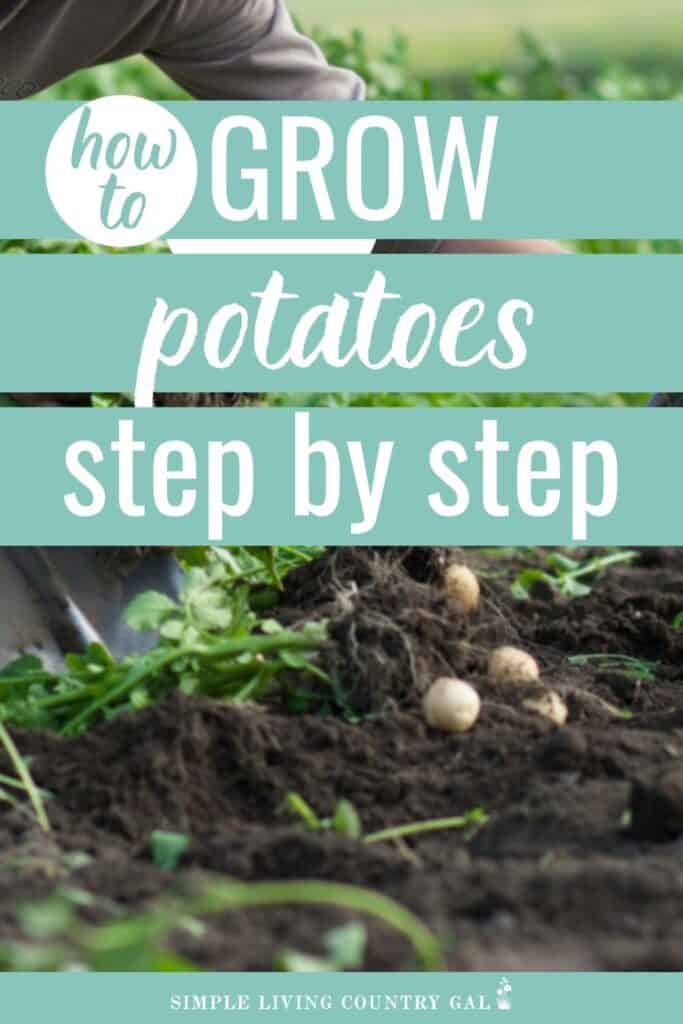
I remember the first time I grew potatoes. I seriously had no idea what I was doing. I just dug a hole, put my seed potatoes in, and waited for them to grow. I did so many things wrong that first year. I didn’t plant them deep enough so they were exposed to the sun giving me a crop of bright green potatoes.
Then I wasn’t sure when to harvest them, so I dug them way too early, leaving me with a bucket of teeny tiny potatoes. And possibly the biggest mistake I made was using a shovel to dig those potatoes up. I misjudged the hole and sliced half of those home grown potatoes in half.
Growing potatoes isn’t hard if you know a few important tips. This simple guide will help to clear things up so you can start growing, harvesting, and storing your Yukon Golds this summer.
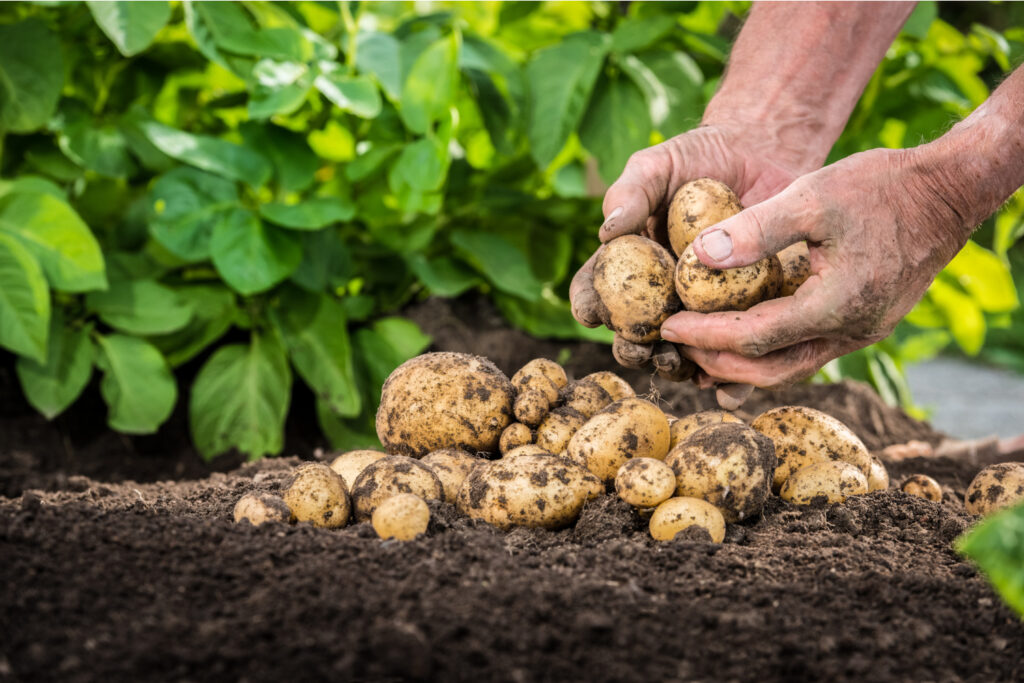
Potatoes are a great addition to any garden. Once you know a few key tips, they are fairly easy to grow and will give you a good supply of potatoes that you can use for weeks to come.
Potatoes grow in a variety of environments, so you can easily grow them no matter where you live. However, you will need to adjust your planting times depending on the weather, and we will talk more about that in a bit.
If you have a large garden, you can plant an entire section. No garden at all? You can grow your potatoes in containers or grow bags out on your back porch.
Unique Growing Tips:
What to Know for Growing Potatoes
Potatoes (AKA: Solanum tuberosum) come in more than 200 varieties, which leaves you plenty of choices when deciding which is the best for your backyard garden. You’re probably most familiar with russet potatoes, sweet potatoes, yellow and red potatoes, and baby potatoes. Each type of potato has highlights that are good to know.
- White potatoes are best used for smashed or mashed potatoes.
- Fingerling potatoes make a nice side dish with their buttery flavor.
- Russet potatoes are perfect for baked or twice-baked recipes.
When deciding what varieties to add to your garden, think about what dishes you’ll make with them and which ones you’ll use the most. Make a list to take with you when you are shopping for your garden seed potatoes.
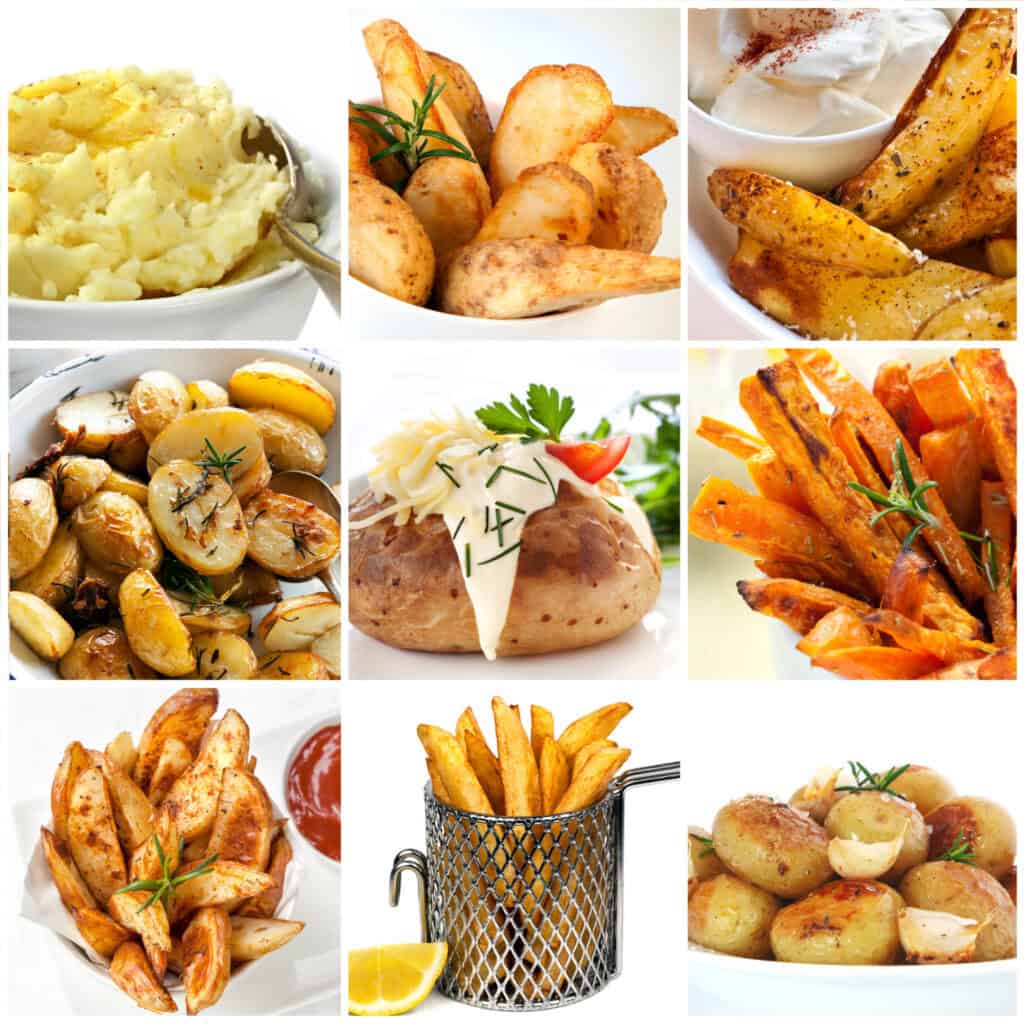
Potatoes grow from tubers that you plant deep in the soil. A tuber is a name for a seed potato and what you will want to purchase for your garden.
Yes, you can plant from potatoes purchased at a grocery store, but your best bet is to buy them from a seed company or local store. This will ensure you are starting out with the very best option, giving you a better chance of success.
Plant Potatoes Near the Best Companions
Companion planting is when you use other plants to grow healthy and hardy food in your garden. This is one of the best ways to use natural defenses to keep pest and disease away from your plants.
For example, potatoes grow well with peas, beans, and corn and may give you larger potatoes at harvest. Planting them near onions or marigolds will help ward off the Colorado potato beetle. Avoid planting potatoes near cucumbers and tomatoes, as they don’t benefit each other and may cause a lackluster crop.
Get more growing tips with our COMPANION VEGETABLE PLANTING GUIDE.
2 Pound Seed Potatoes, Red Potato Seeds, Potato Seeds for Planting, Heirloom Seed Potatoes for Growing, Potato Tubers

What You Need to Grow Potatoes
As mentioned earlier, potatoes grow well in both the ground and containers. Which planting method you choose depends entirely on two factors: how much space you have and how big a harvest you’d like.
Growing in containers will undoubtedly produce a smaller harvest, but container gardens are perfect for smaller spaces like patios, decks, and tiny yards and they work well for small families. If space allows, planting in the ground will yield a much larger harvest, which is perfect for a larger family.
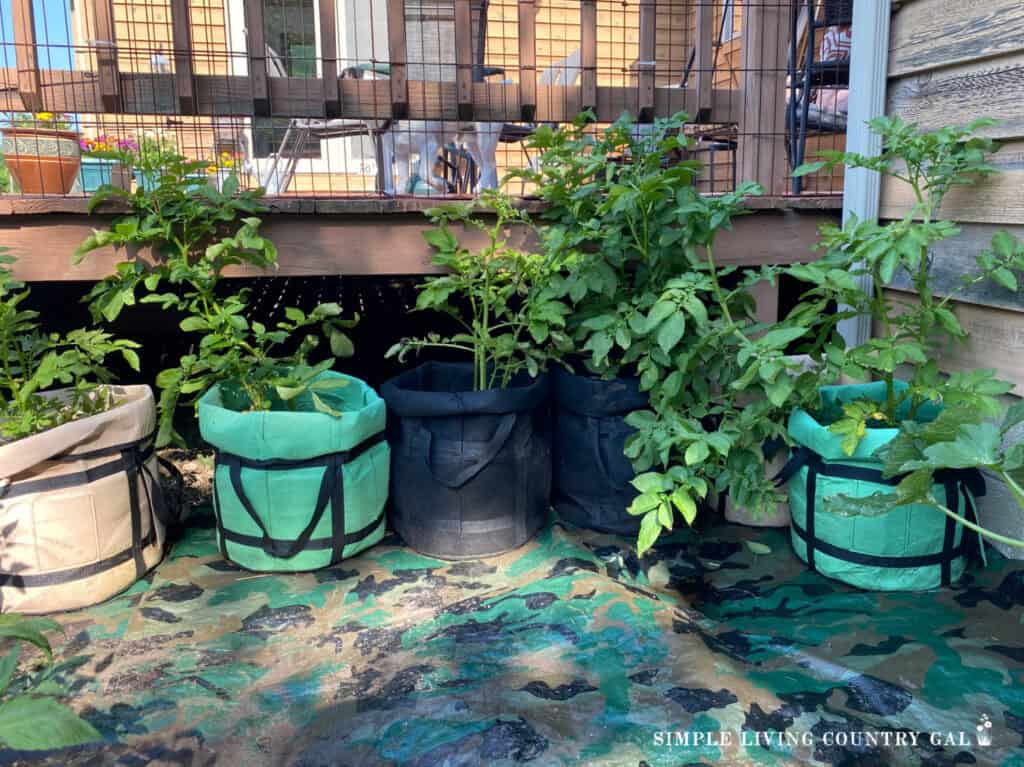
Temperature
Potatoes love cooler weather and will do well in milder temps. They can tolerate temperatures up to 80 degrees but they don’t produce as well in hotter weather. If you live in a hot climate, it is best to plant them as a winter crop when the weather is cooler.
Spring, early summer, and fall are the best times of the year for this vegetable to thrive, when the weather is not too hot or too cold. If you live in a cold climate, you will want to plant your potatoes when you are able to work the ground.
Sun
As for sunshine, the leaves and stems love full sunlight, but the potatoes growing underground do not. As potatoes grow, they will push up to the surface and may become exposed to the sun.
You can protect your harvest by placing a layer of mulch over the soil. This will keep your potatoes from being exposed to the sun, which can turn them green and reduce their flavor.
Plant your potatoes in an area where you get at least 6 hours of full sunlight a day. I like to check things daily to be sure there are no potatoes surfacing. If I see any, I can cover them with a layer of soil or add mulch to protect them. Surfacing can happen in a traditional garden as well as in containers.
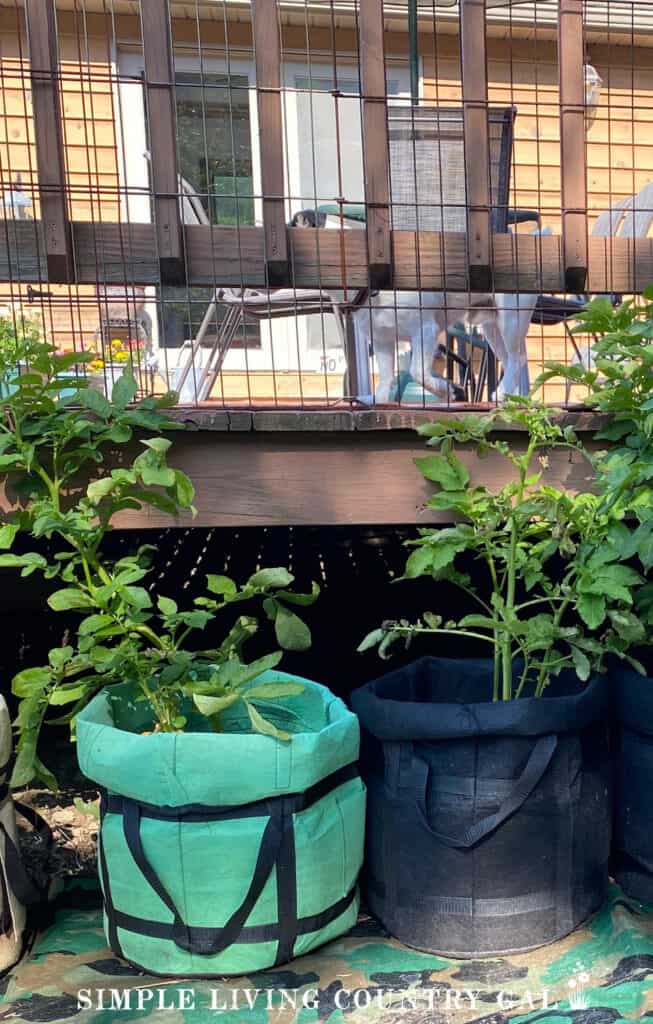
SLCG PRO TIP: Get into the habit of walking your garden once a day. This will help to alert you to any issues early enough so you can fix them before you suffer too much damage.
Soil
Unlike many other vegetables, potatoes thrive in acidic soil with a pH of 4.8-5.5. If you are not sure what the PH of your soil is, you can get a testing kit. Remember to keep track of your soil’s PH in your garden planner.
Square Foot Garden Planner+Guide

When planting in the ground or choosing soil for your planter, it’s important to keep the required soil PH in mind both for your potatoes and any companion vegetables you might be thinking about. Potatoes are capable of being tolerant of a variety of soils though, except for clay.
Drainage is another factor you’ll want to keep in mind because too much water will rot any potatoes growing.
Good areas to plant potatoes are:
- Grow bags
- Raised garden beds
- Traditional garden with layered soil
- In mounds or raised rows
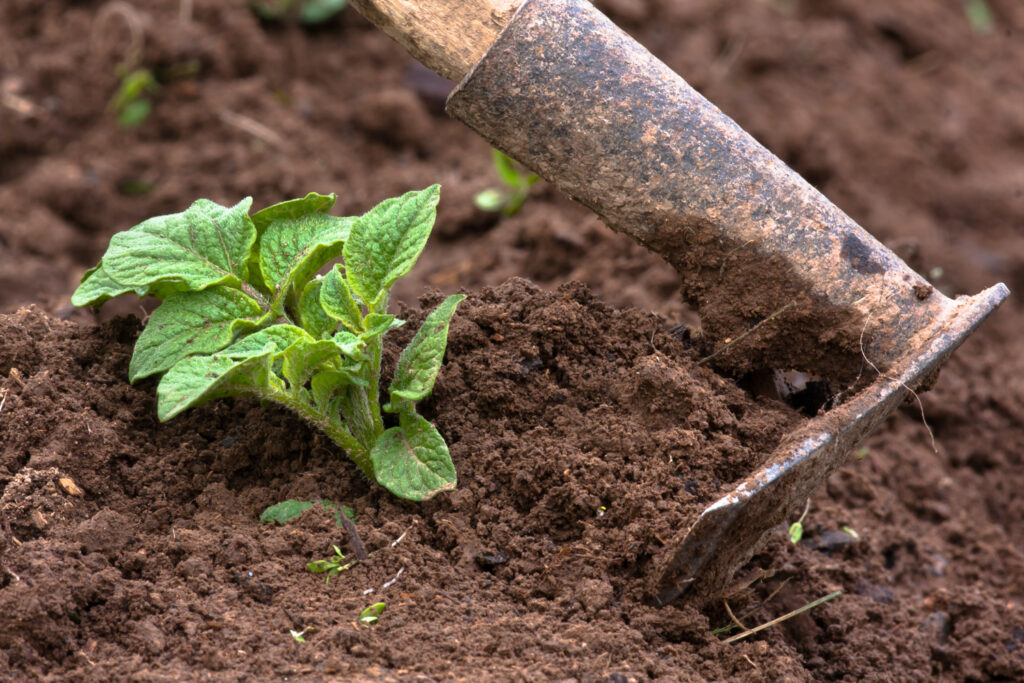
Watering
Potatoes need enough water without giving too much. The best way is to always check the soil before watering. You want soil that is moist but not overly wet, as this will ensure the best growth. You can use a water monitor gauge or stick your finger into the soil around the base of the plant.
The top of your soil can seem dry due to the sun evaporating moisture from the surface, while the soil underneath stays moist. Watering 1-2 inches per week is usually optimal, and water evenly to ensure a more uniform harvest. Try to water evenly so you produce more uniform potatoes.
You can stop watering late in the season when the leaves die back and you’re ready to harvest. This is usually about two weeks before you begin harvesting.
Fertilizing
Potatoes need nutrients to thrive so be sure to add compost to your soil when planting. About halfway through the growing season, you may want to add more compost to the soil around your potatoes. If you do not have compost you can use, instead, an organic fertilizer specifically for potatoes.
How Many Potatoes to Plant
When planting potatoes, you will want to plant one tuber or plant about every foot in your garden to give them space to grow. One potato plant will yeild about 5-10 potatoes so 10 plants will give you about 50-75 potatoes at harvest.
To ensure you have enough potatoes at harvest, you can plant 10 plants per person or about 40 plants for a family of four.
If you are growing potatoes in containers it is best to keep one plant per container. This will allow your plants the room they need to grow a good and healthy harvest.
READ: RAISED BED (AKA SQUARE FOOT) GARDENING
When to Plant Potatoes
As we talked earlier, potatoes are cool weather vegetables so the best time to plant is in early spring, about 2-3 weeks before your last frost for best results. The soil should be at least 50°F and shouldn’t be so wet that it sticks together.
The best planting time ultimately depends on your climate zone as laid out by the U.S. Department of Agriculture. For instance, in using this guide, zone 9 lists the best planting season as January through March but zone 10 recommends September through March. Potatoes grow best in zones 3 through 10b. Be sure to check the climate zone guide to determine your zone and the best planting time.
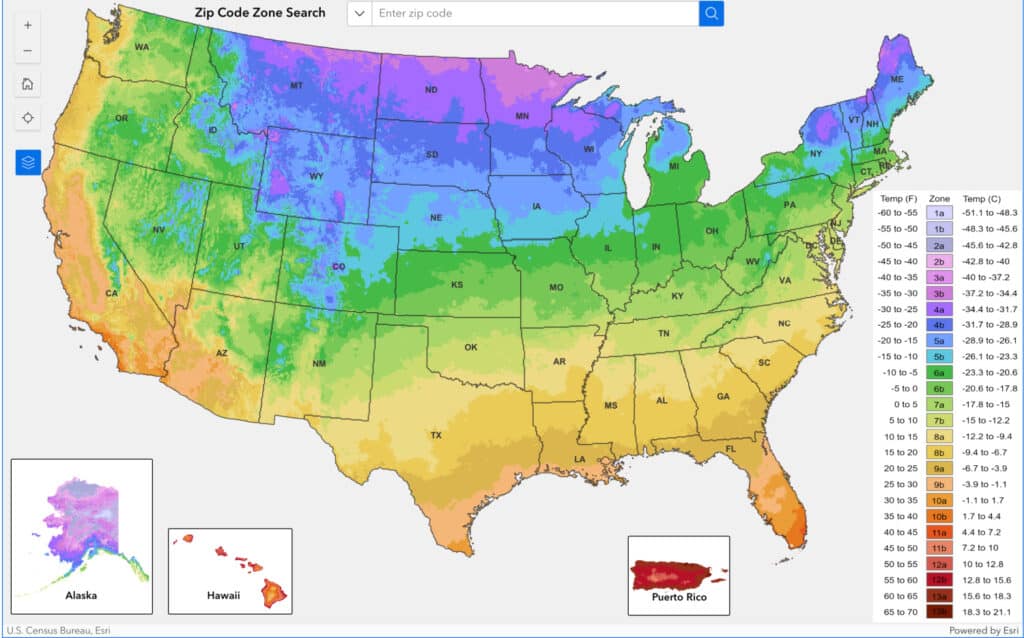
One other factor you may want to consider is harvest time. If there’s a certain time you would like to harvest, take that into consideration along with the zone guide and growing time for the particular potato plant you’re growing.
How to Plant Potatoes
If you’re planting in a container or raised bed, you’ll need to make sure you have enough space for the number of plants you want to plant, meaning you may need more than one container. And if you’re planting in the ground, you’ll need to prepare the soil. Scroll above to read more tips on soil prep.
It is best to grow potatoes in rows that are spaced about 3 feet apart ideally. If you’re tight on space, you’ll still want to allow a minimum of a foot between plants. If you live in a wet area, raised rows will help you to control the moisture.
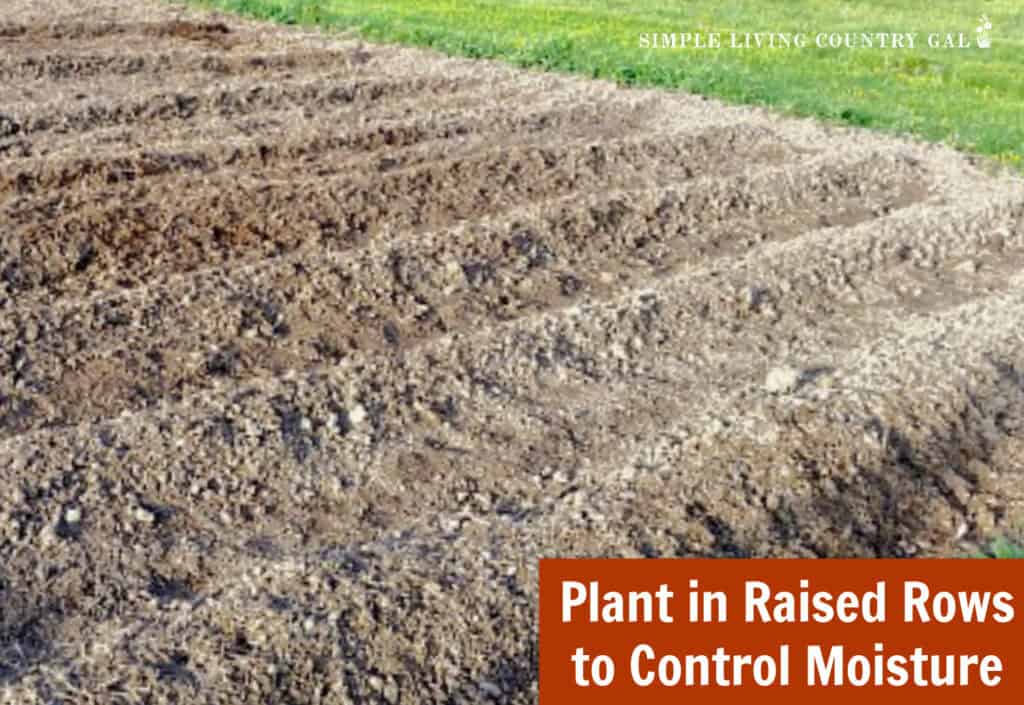
If you’re planting in the ground, you’ll need to trench the soil prior to planting. This means creating a trench in the ground using a hoe or other gardening tool. Your plant area or trench will need to be about 8 inches deep; you can taper the hole down as you dig, starting about 6 inches wide and finishing at about 3 inches wide.
If your soil is too rocky to dig, you can, instead, place your seed potato on the ground and sprinkle it with a mixture of soil, and compost then covering it with straw. With this method, you’ll want to hill the materials up around your potato plant as it grows.
Just keep an eye on your crop and as you begin to see growth, use your hoe to pull the soil up around the plant to keep your potatoes out of the sun’s exposure.
While you can certainly use seeds, the best starters for planting are seed potatoes. These are potatoes that have protruding eyes (buds). Using a clean, sharp knife, cut the potatoes into pieces that are about the size of a golf ball. Each piece should have at least 2 eyes.
If you’re planting smaller potatoes, like red, fingerling, or baby potatoes, you can plant them whole.
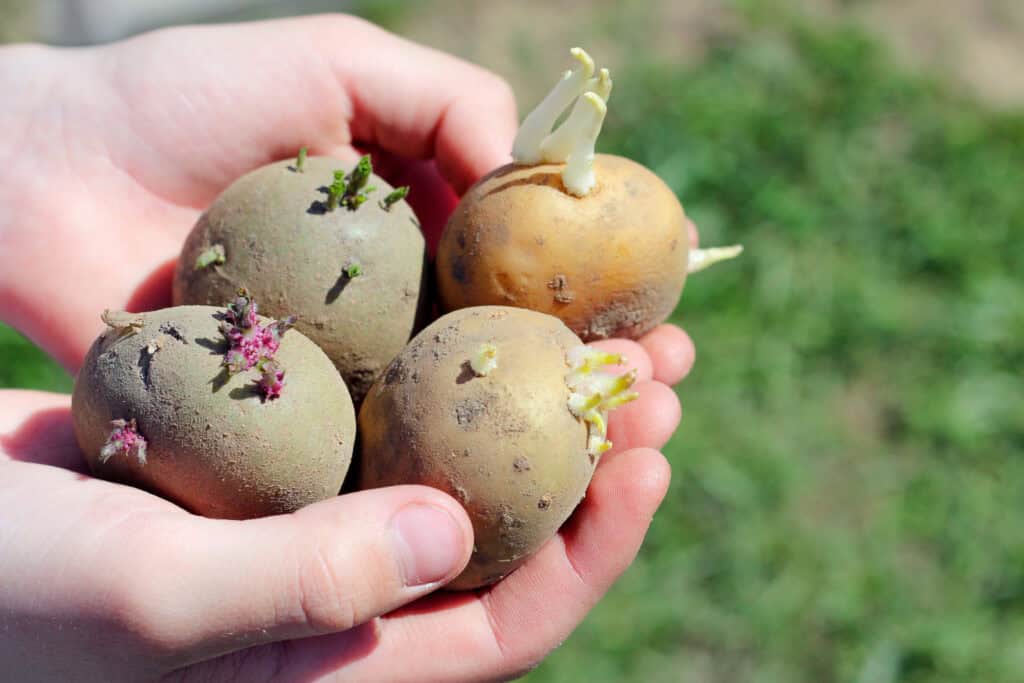
Cut your seed potatoes a day or two before planting; this will give them time to grow a protective layer over the cut surface, improving moisture retention and keeping them from rotting.
In each trench or hole, place a seed potato piece with the cut side down about every 12-18 inches and cover with only 3-4 inches of soil. For potatoes, you will want to cover as they grow adding on more soil routinely during the growing time.
Sprouts will start to appear in about 12-16 days. At this point, gently fill the trench with another 3-4 inches of soil using a hoe. Remember to leave a few inches of the plant exposed. Continue to do this for several weeks until you’ve created a mound of about 4-5 inches above the ground. This is called hilling.
Once the potato plants emerge, you can add organic mulch between the rows to help conserve water and reduce weeds. This will also help to keep the soil cool.
How long it will take your potatoes to grow depends on the variety you plant. Baby potatoes grow in about 2-3 weeks while larger varieties can take anywhere from 6 weeks to 4 months.
Your potatoes will be ready to harvest with the foliage above the ground begins to die. It is important to note that the tops of the plants need to completely die before you can begin harvesting. You can help your potatoes last longer after harvest by not watering them at the end of the growing season, this is about 2 weeks before harvest begins.
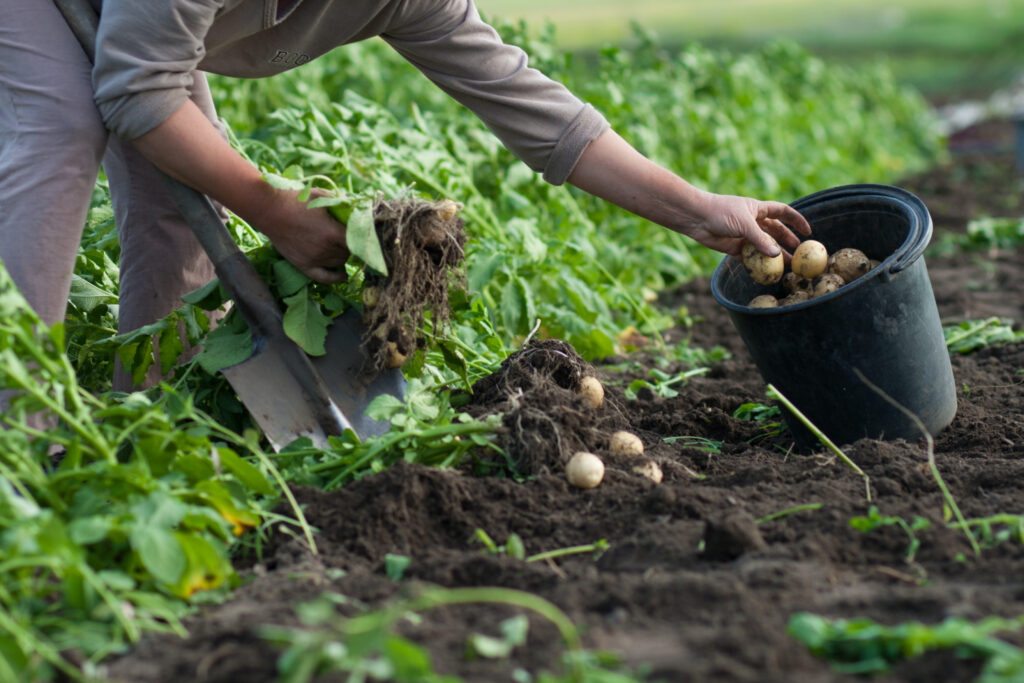
Before you harvest you will want to see if your potatoes are surely ready. You can start by digging up just one plant to see how it’s matured. The skin of the potato should be thick and firmly attached to the flesh. If it’s not ready yet, wait a few more days before harvesting the rest of your plants.
It is good to know that potatoes can withstand a light frost, but if a heavy frost is expected, you’ll want to get your potatoes out of the ground. For this reason, it is important to watch the weather so you have time to get your crop out if a cold snap is expected.
A good harvest plan for your potatoes is:
- Cut the dead foliage off that is above the ground and leave the potatoes in the ground for another 10-14 days, but no longer.
- Dig your potatoes up on a dry day, being careful not to damage them.
- Try to avoid cutting or bruising the skin, that will make them rot faster.
- If they’re damp, let them air dry before storing them, but do so inside, don’t leave them in the sun. Too much direct sun can turn the potatoes green and give them a bitter taste.
Things to Watch for When Growing Potatoes
The starchy flesh of potatoes is an attraction for many pests, especially wireworm which is the larvae form of click beetles. Moles and mice will also be attracted to your potatoes. Some gardeners plant “sacrificial plants” on the outskirts of their garden to attract the pests there and away from other plants.
The Colorado potato beetle is another pest to be on the lookout for. It’s a large, orange and black striped beetle (their larvae are dark red) and they’ll eat the potatoes down to nothing.
Fungal and bacteria rot can also damage the roots of your plants. This usually comes from soil that’s too damp. Keeping your soil moist, but not overly saturated will help curb this. Be sure not to replant infected tubulars or seed potatoes as they’ll pass any disease on to the new plants.
SLCG PRO TIP: As mentioned earlier it is helpful to walk your garden every day looking for any issues. This will help you to stop diseases before they get out of hand or set up other prevention measures to stop deer or rabbits from taking advantage of all your hard work.
Additional Planting Notes
Be sure to mix compost into your soil prior to planting to provide enough nutrients to help your plants thrive. Potatoes need a lot of nutrients. You can add additional compost as you continue to add soil over the plant as it grows to really ensure you are creating the very best environment.
Laying mulch over your soil will help with drainage, reduce weeds, and keep the soil cool when the temperatures are high. You don’t need a lot, just a thin layer will do the trick.
READ: HOW TO MULCH YOUR GARDEN FOR THE VERY BEST HARVEST
Your plants shouldn’t need pruning as they grow and by keeping the above ground plants growing, this is the best way to know when your potatoes are ready for harvest. Remember, when the plants above the ground start to die, you’re just about ready to harvest. Wait for the plants to completely die plus an additional 10-14 days, then it’s time to dig up your potatoes just to be sure.
Growing potatoes is one of the easiest plants for beginner gardeners and can provide a plentiful harvest for your family. Get the family involved, plan your garden, and start digging.






